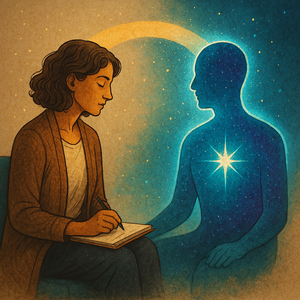Blog
Listening to Your Inner Voice: A Practice in Everyday Intuition
In a world that rewards constant doing, it can feel radical to slow down and listen inward. Yet your inner voice, the intuitive wisdom that lives beneath thought, has always been there, waiting. This is the heart of intuitive therapy: learning to trust the quiet guidance within you.
Begin With Stillness
Before intuition can be heard, the body needs safety. A calm nervous system is the soil where inner knowing can take root.
Start small: feel your feet against the ground, notice your breath, or place a hand over your heart for a few steady inhales. These grounding moments reconnect your body and mind, opening the door for insight.
Notice What Expands You
Intuition doesn’t shout, it whispers through subtle sensations of ease, openness, and warmth. Begin to observe what expands you and what contracts you. A “yes” often feels light; a “no” feels heavy.
This is one of the guiding principles in mindfulness-based counseling: the wisdom of your body is often more honest than your thoughts. When you start to honor those sensations, decision-making becomes more peaceful and aligned.
Build a Relationship With Your Inner Voice
moreHow Therapy Mirrors Rituals: A Sacred Process of Healing
Sometimes, rituals and ceremonies are used interchangeably. The main difference between them is that rituals are often smaller and more private, while ceremonies are more formal and public.
Rituals and therapy share a profound connection, offering a path to inner transformation. While rituals tend to be personal and intimate, therapy often serves as a structured space for healing. Here’s how the two align:
- Setting Intentions: Just as in rituals, therapy begins by setting clear intentions. What do you seek healing for? What areas of life need support and care?
- Symbols and Tools: In therapy, symbols could be personal objects, techniques, or methods that resonate with your healing process. Whether it’s mindfulness practices, journaling, or visualizations, these tools act as meaningful elements guiding you toward clarity.
- Creating Sacred Space: Therapy becomes a sacred space where a calm, supportive environment is created. The setting allows for deep introspection and safety, whether in the therapist's office or during a session in your chosen space.
- Structured Process: Like rituals that follow specific steps, therapy has an intentional structure. Sessions progress with purpose, guiding you through exploration, healing, and integration in a grounded way.
moreWhere Psychology Meets Spirituality: The Bridge Between Worlds
I love learning and teaching about the intersection of psychology and spirituality. As a psychotherapist and a client, I have learned how healing happens on so many levels. If you are a therapist, healer, etc., have you ever sat with a client, or maybe with yourself, and realized the healing wasn’t just emotional but energetic? That what needed tending to wasn’t just the story, but the soul underneath it? That’s the space I love exploring, and that’s why I work somatically, because the body is an easy entrance to that realm.
That’s the bridge between psychology and spirituality.
As therapists, we are trained to track patterns, observe micro and macro facial expressions, name trauma, and offer tools rooted in evidence. But so often, healing shows up in dreams, synchronicities, gut feelings, and the quiet voice of the inner knowing. It’s the tears that come out of nowhere. The chill sensations when truth is spoken. The client who says, “I don’t know why, but I feel lighter.”
Spirituality doesn’t compete with psychology; it completes it. It invites us to remember that we’re not just minds or behaviors, but whole beings with intuition, energy, and a longing for meaning. Real transformation often happens where science meets spirit, where the clinical meets the mystical.
more

